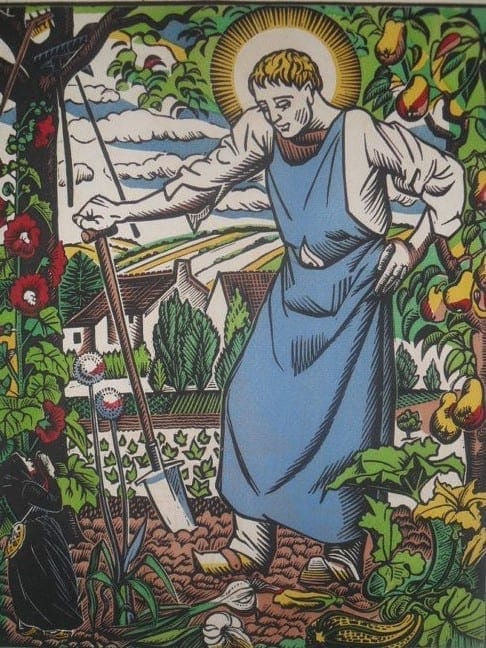1 September 2020
Digging deep for a Saint

Anthony Edward Dundon
Anthony is a London-based writer and is a member of the Chartered Institute of Editing and Proofreading
In the foyer of Saint Mark’s Hospital, a world-renowned London hospital that specialises in the treatment of intestinal and colorectal medicine, stands a solemn effigy of a seventh-century saint. The statue is of Saint Fiacre, patron saint of gardeners, sufferers of haemorrhoids, fistulas, kidney stones and other bodily ailments.
Dressed in what appears to be coarse clothing that was worn by peasant farmers of the era, he holds a long spade at his left-hand side and his gaze is directed at the ground. The effigy was gifted to the hospital by the daughter of Professor Basil Morson, a famous pathologist.
Fiacre (c ad 600 – 670) was born in Ireland. His lineage stemmed from the legendary Conn, of the Hundred Battles, King of Ireland (c ad 113? – 157). As a boy he liked to listen to the birds in spring and hear the hum of the bees. In autumn, he liked to gather brown-coloured leaves, which he gave to his elders to use in their burning stoves.
Fiacre (Fiachra in Gaelic) means a “battle king” and appears in Irish folklore. In the legend of the Children of Lir, Fiachra, one of Lir’s children, was put under a spell by his stepmother, Aoife. King Lir’s first wife Eva died and he married Eva’a sister, Aoife, whose spell was to turn all four of Lir’s children into swans. The spell would only be broken on the arrival of Saint Patrick in Ireland. Like other saints of this period, many myths and contradictions abound.
From an early age, Fiacre showed great generosity towards the poor and downtrodden. He was known for his knowledge and skills of the land and of planting. With these horticultural skills, Fiacre soon became engrossed in the study of medicinal herbs. His parents wanted him to stop studying and to enjoy life.
His father felt that marriage might transform his resolve, but Fiacre had no wish to marry. He became holier and drew strength from Jesus, God the Father and the Blessed Mother of God. As his reputation and skills grew, people sought his help for the alleviation of their illnesses and infirmities. He was eventually ordained a Catholic priest and later became an abbot.
Fiachra’s Well, Cill Fiachra near Bennetsbridge in County Kilkenny, Ireland, was opened in 1999. The site commemorates his birthplace and marks the site of Fiachra’s hermitage and monastery. Many people make an annual pilgrimage to this holy well, which is close to the banks of the river Nore. Devotion to the saint waned during the 1950s and 1960s, but locals who maintained the faith revived it again.
In 1992, a new parish church was opened and dedicated to Fiacre. The water in the well is deep, but there is no evidence of anyone being baptised in this water. Legend claims that the waters of the well can protect people, especially sea voyagers. This legend arose from the story of a native of the area; in 1775, a sea captain called James Casey was returning to Ireland. His ship hit a ferocious storm and he feared for his life and his crew. While many of the crew panicked, Casey invoked Fiacre’s help. The storm subsided and they made it safely to land. Many people who journey to Europe or America now carry a bottle of holy water from the well. As a form of thanksgiving, Casey had a large, silver cross erected at the church of Graiguenamanagh, which is still standing.
In his search for silence and solitude, Fiacre set sail for Meaux, France in ad 626 or 628. Saint Faro, bishop of Meaux, granted him a parcel of land at Breuil in northern France. To construct a ditch, Fiacre dragged his cane along the dirt, causing furrows to sink into the earth and trees to sprout from the ground. The ditch protected Fiacre, his monks and the monastery from the outside world. The ditch was regarded as a miracle, but one woman considered it witchcraft which offended the saint. All women were then barred from the monastery.
In this plot Fiacre built a hermitage, a vegetable garden and an oratory to Mother Mary. He also built a shelter where he cared for the sick and those who sought his advice. He lived a life of seclusion and mortification that was devoted to prayer, fasting and cultivation of the land.
Even after Fiacre’s death, visitors and pilgrims came to seek cures and show devotion to him. He cured many illnesses by laying on of his hands. The penalties were harsh for women who attempted to enter the precincts of the monastery. Divine punishment in response to their wrongdoing was one such eventuality, and this could be associated with madness or another more serious illness. One account tells of a woman who pushed her maid into the chapel and became blind. Other accounts, however, contradict these stories.
Fiacre was noted for curing worms, fistulas, kidney stones, skin ailments and venereal diseases like syphilis, but his special interest was relieving haemorrhoids and fistulas. Cardinal Richelieu, chief minister to Louis XIII of France held the positions of bishop and later cardinal from 1624 until his death in 1642. He suffered from haemorrhoids and in the 17th century went to the monastery in search of a cure. He asked that the saint’s bones be applied to the area of his ailment. When he had obtained relief, he ordered a vertebra of the saint be brought to Paris to alleviate the painful haemorrhoids.
Anne of Austria, queen of France and wife of Louis XIII, also sought the saint’s intercession because of her 23-year childless marriage. She went to Meanx in 1641 and subsequently gave birth to a son, who later became Louis XIV.
Fiacre died on August 18, 670. His relics were preserved at a shrine in his local church – the hermitage, hospice and oratory – nowadays in Saint-Fiacre Seine Marne. His remains were transferred to Meaux Cathedral in 1568, where they remained for veneration throughout the 17th and 18th centuries.
All that remains of his relics now are his tomb and the so-called magical millstone, on which it is alleged Fiacre sat to relieve his own haemorrhoids. These are now placed in the local village church, which was built in 1659 and where Mass is celebrated once a month.
The feast day of St Fiacre, the Patron Saint of Gardeners, is celebrated on August 30 or September 1.

